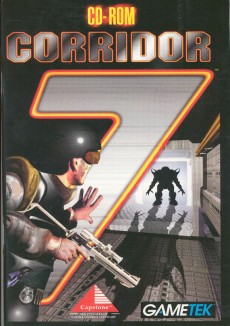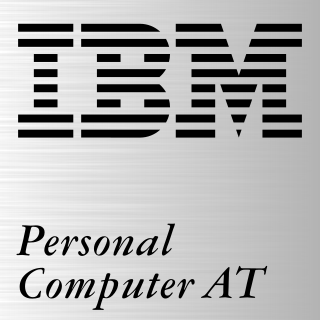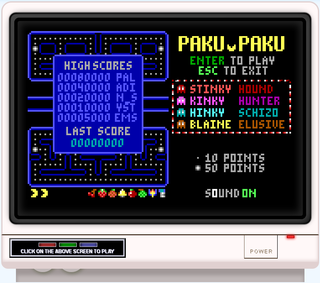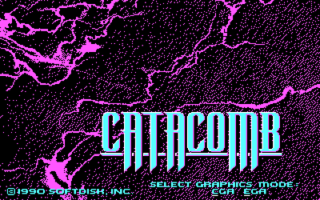
Quake II is a 1997 first-person shooter video game developed by id Software and published by Activision. It is the second installment of the Quake series, following Quake. The game's storyline is continued in its expansions, including one tying in Quake II and the first game, and Quake 4.
System Request is a key on personal computer keyboards that has no standard use. Introduced by IBM with the PC/AT, it was intended to be available as a special key to directly invoke low-level operating system functions with no possibility of conflicting with any existing software. A special BIOS routine – software interrupt 0x15, subfunction 0x85 – was added to signal the OS when SysRq was pushed or released. Unlike most keys, when it is pressed nothing is stored in the keyboard buffer.

Video Graphics Array (VGA) is a video display controller and accompanying de facto graphics standard, first introduced with the IBM PS/2 line of computers in 1987, which became ubiquitous in the IBM PC compatible industry within three years. The term can now refer to the computer display standard, the 15-pin D-subminiature VGA connector, or the 640 × 480 resolution characteristic of the VGA hardware.

Corridor 7: Alien Invasion is a first-person shooter video game developed by Capstone Software and published by IntraCorp and GameTek. The game was poorly received, largely due to its use of the outdated Wolfenstein 3D engine. A sequel, Corridor 8: Galactic Wars, was announced but later canceled.

The IBM Personal Computer AT was released in 1984 as the fourth model in the IBM Personal Computer line, following the IBM PC/XT and its IBM Portable PC variant. It was designed around the Intel 80286 microprocessor.

Nibbles, also known by the source code's file name NIBBLES.BAS, is a variant of the snake video game concept used to demonstrate the QBasic programming language. Nibbles was written in QBasic by Rick Raddatz, who later went on to create small businesses such as Xiosoft and Bizpad.

Red Baron is a combat flight simulation video game for MS-DOS created by Damon Slye at Dynamix. It was published by Sierra On-Line in 1990. The game was ported for Amiga and Macintosh computers in 1992.

DOS/V is a Japanese computing initiative starting in 1990 to allow DOS on IBM PC compatibles with VGA cards to handle double-byte (DBCS) Japanese text via software alone. It was initially developed from PC DOS by IBM for its PS/55 machines, but IBM gave the driver source code to Microsoft, who then licensed a DOS/V-compatible version of MS-DOS to other companies. Kanji fonts and other locale information are stored on the hard disk rather than on special chips as in the preceding AX architecture. As with AX, its great value for the Japanese computing industry is in allowing compatibility with foreign software. This had not been possible under NEC's proprietary PC-98 system, which was the market leader before DOS/V emerged. DOS/V stands for "Disk Operating System/VGA". In Japan, IBM compatible PCs became popular along with DOS/V, so they are often referred to as "DOS/V machine" or "DOS/V pasocom" even though DOS/V operating systems are no longer common.

Witchaven is a dark fantasy first-person shooter video game developed by Capstone Software and published by Intracorp Entertainment in 1995. Its sword-and-sorcery themed story tasks the knight Grondoval with a quest to seek out and destroy a lair of witches in their titular fortress, fighting hordes of hostile monsters along the way. Witchaven features action role-playing elements such as leveling, as well as an emphasis on melee combat. Its code was based upon an early version of the nascent Build engine. The game received overall mixed reviews, such as praise for its atmosphere and gory combat, but criticism for some aspects of gameplay. It was followed by a sequel titled Witchaven II: Blood Vengeance in 1996.

A personal computer game, also known as a computer game or abbreviated PC game, is a video game played on a personal computer (PC).
Donkey, often known by its filename DONKEY.BAS, is a video game written in 1981, and included with early versions of the IBM PC DOS operating system distributed with the original IBM PC. It is a top-down driving game in which the player must avoid hitting donkeys. The game was written by Microsoft co-founder Bill Gates and early employee Neil Konzen.

The PS/2 port is a 6-pin mini-DIN connector used for connecting keyboards and mice to a PC compatible computer system. Its name comes from the IBM Personal System/2 series of personal computers, with which it was introduced in 1987. The PS/2 mouse connector generally replaced the older DE-9 RS-232 "serial mouse" connector, while the PS/2 keyboard connector replaced the larger 5-pin/180° DIN connector used in the IBM PC/AT design. The PS/2 keyboard port is electrically and logically identical to the IBM AT keyboard port, differing only in the type of electrical connector used. The PS/2 platform introduced a second port with the same design as the keyboard port for use to connect a mouse; thus the PS/2-style keyboard and mouse interfaces are electrically similar and employ the same communication protocol. However, unlike the otherwise similar Apple Desktop Bus connector used by Apple, a given system's keyboard and mouse port may not be interchangeable since the two devices use different sets of commands and the device drivers generally are hard-coded to communicate with each device at the address of the port that is conventionally assigned to that device.

F-15 Strike Eagle is an F-15 Strike Eagle combat flight simulation game released for Atari 8-bit computers in 1984 by MicroProse then ported to other systems. It is the first in the F-15 Strike Eagle series followed by F-15 Strike Eagle II and F-15 Strike Eagle III. An arcade version of the game was released simply as F-15 Strike Eagle in 1991, which uses higher-end hardware than was available in home systems, including the TMS34010 graphics-oriented CPU.

Triplane Turmoil is a sidescrolling dogfighting flying game for MS-DOS by Finnish developer Dodekaedron Software. The game is based on the 1984 MS-DOS game by David Clark, Sopwith. Originally released as shareware, in 2009 Dodekaedron placed the source code, documentation, images and sounds under the GPLv3 on SourceForge, hosted later on github.com. The community continued the support and ported the game via SDL to other platforms including Linux and Windows.

Kiloblaster is a fixed shooter video game trilogy written by Allen Pilgrim and published by Epic MegaGames in 1992 for IBM PC compatibles. Based on Namco's Galaxian from 1979, there are a few differences such as allowing greater player movement, much faster enemy movement, power-ups, enemies that take more than one hit, and allies to assist in battle.

C-Dogs, the sequel to Cyberdogs, is a shoot 'em up video game where players work cooperatively during missions, and against each other in "dogfight" deathmatch mode.

Catacomb is a 2-D top-down third-person shooter developed and published by Softdisk. It was originally created for the Apple II, and later ported to the PC. It supports EGA and CGA graphics. Catacomb is programmed by John Carmack, who would later work on successful games such as Wolfenstein 3D and Doom. The fast action and the ability to strafe in Catacomb foreshadow Carmack's later work. The enemy movement code in Wolfenstein 3D is based on code from Catacomb.

DOS is a family of disk-based operating systems for IBM PC compatible computers. The DOS family primarily consists of IBM PC DOS and a rebranded version, Microsoft's MS-DOS, both of which were introduced in 1981. Later compatible systems from other manufacturers include DR-DOS (1988), ROM-DOS (1989), PTS-DOS (1993), and FreeDOS (1998). MS-DOS dominated the IBM PC compatible market between 1981 and 1995.

F-16 Combat Pilot is a 1989 F-16 fighter flight simulator created by British software company Digital Integration Ltd. for Amiga, Atari ST, DOS, Commodore 64, Amstrad CPC and ZX Spectrum. It is considered as one of the first combat flight simulators to have a dynamic campaign environment. While the graphics, scenery and audio are quite sparse and basic, the instruments and flight dynamics of a F-16C Fighting Falcon are fully featured and modeled.
The ATI Wonder is a series of video cards for the IBM Personal Computer and compatibles, introduced by ATI Technologies in the mid to late 1980s. These cards were unique at the time as they offered the end user a considerable amount of value by combining support for multiple graphics standards into a single card. The VGA Wonder series added additional value with the inclusion of a bus mouse port, which normally required the installation of a dedicated Microsoft Mouse adapter.

















